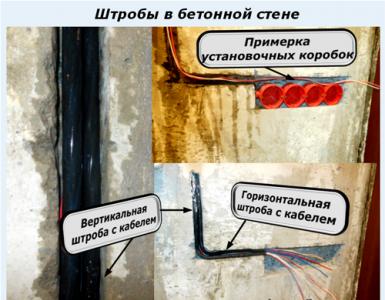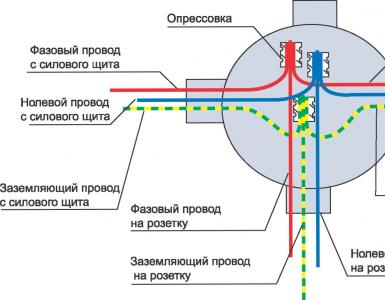How to make a sewer in the country with your own hands?
The modern concept of comfort is incompatible with the lack of sewerage. This statement is equally true for cottages and cottages. If you have purchased a cottage with "outdoor conditions", it is not at all necessary to call the masters to equip the sewer, you can organize it on your own. Let's talk in detail about all the aspects related to the laying of this important engineering communication.
If we discard the variations, then five solutions remain:
- Installation of a dry closet.
- Pit system.
- The use of storage capacity.
- Natural cleaning system based on a septic tank.
- Biological treatment method.
Let's briefly characterize each of them.
Dry closet installation
This is the simplest and fastest solution, but should be considered rather as a temporary measure, since the issue of removing wastewater from the sink, washbasin or shower remains open. In addition, such an implementation does not exclude the appearance of an unpleasant odor.
Pit System
A few decades ago, this was the most common solution; at the moment, it has lost its relevance due to the emergence of more efficient systems. The only advantage of such an implementation is the relatively low cost. The disadvantages of the solution are manifested in the form of: the need to limit the flow of water, the presence of an unpleasant odor and pollution of the site.
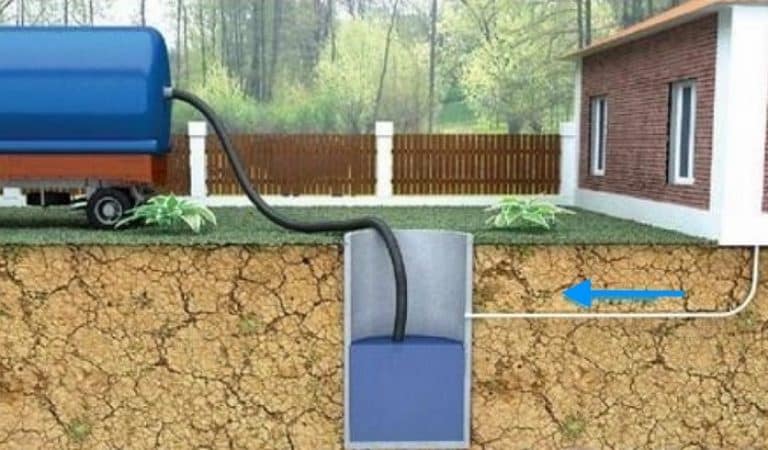
Given all the shortcomings, the use of such a solution can be justified in the absence of running water in a private house.
Note that this type is unacceptable for areas with a high level of groundwater or in the presence of clay soil.
The use of storage capacity
In fact, this type can be considered as a variation of the previous species. The main differences are a completely sealed design and more frequent pumping. The advantages include:
- a wide variety of volumes (usually from 2 to 100 m 3);
- depending on the version, ground or underground placement is possible;
- connection of storm sewers is allowed;
- does not pollute the soil.

Before choosing this implementation option, it is necessary to take into account its two significant drawbacks:
- given the limited volume, water consumption should be controlled;
- you will need to call vacuum trucks for cleaning about once a month.
The justified scope of this type of autonomous sewage system is: a small private or summer country house that is not connected to a water supply, a place of temporary residence, for example, a construction village.
Natural cleaning system based on a septic tank
This design consists of 2-4 cleaning sections. The greater their number, the higher the degree of wastewater treatment. The outlet is connected to the drainage system.

The main advantages of the solution:
- simple implementation and affordable cost;
- connection to external power sources is not required;
- there is no unpleasant odor;
- the soil is not polluted;
- a large selection of prefabricated designs.
For the shortcomings of this system, the definition is more suitable - features of operation, they are expressed in the following:
- the system must not be overloaded, as this can lead to an unpleasant odor in the drainage field;
- mechanical cleaners need regular inspection, according to its results, the need to clean the tanks and the drainage system is determined. The frequency of preventive measures is once a year.
The main scope of application is private houses, cottages, cottages with a small and medium volume of effluents.
Biological treatment method
Biological stations are the most effective way to treat wastewater. The design resembles a septic tank, but there are also differences, they are expressed in the presence of an aeration tank, a biofilter, a check valve, a pump, etc. These additional elements make it possible to use the outlet water for technical needs or organize its discharge directly into the reservoir.
Several houses connected to the biological station through a common collectorUsing a biological station provides the following benefits:
- wastewater treatment by 98%;
- long-term operation with minimal maintenance;
- there is no smell;
- according to the norms of SNiP, close proximity to a residential building is allowed;
- non-degradable waste is accumulated in a minimal amount, which reduces the regularity of prevention.
A significant disadvantage of such systems is their high cost. Note that connecting several houses to a single cleaning station allows you to reduce the cost of purchasing it. In addition, biological complexes are dependent on the presence of electricity.
Sewerage device in the country
You need to start by choosing the type of system. To create comfortable conditions, the most optimal option for mechanical cleaning. This is due to the fact that a dry closet is a temporary measure, a cesspool is a source of pollution and an unpleasant odor, a storage tank requires frequent cleaning, and a biological station is too expensive.
We propose to consider the device of a septic tank in order to better understand its principle of operation. In Figure 6, black arrows indicate the movement of wastewater inside the structure.
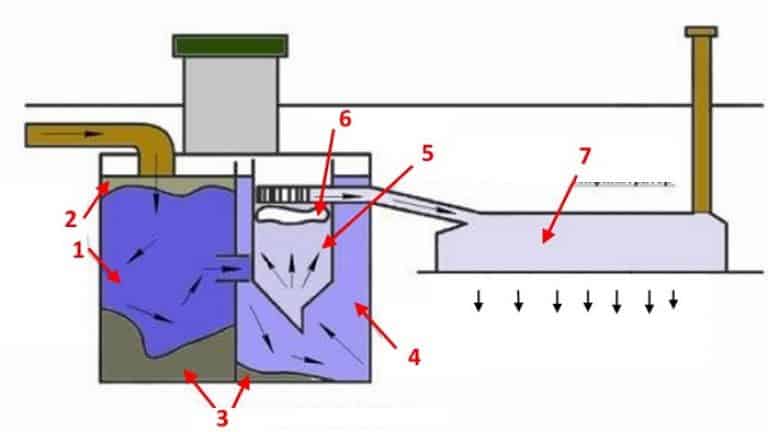
Rice. 6. The device and principle of operation of the septic tank "Tank"
Designations:
- The first section (primary sump).
- light fractions.
- Insoluble precipitate (sludge).
- The second section (filtering sump).
- filter box.
- Biological filter.
- Drainage (infiltrator).
Work algorithm:
- The input is carried out in the first section (1 in Fig. 6), where wastewater is decomposed into fractions. Light elements move up (2), heavy elements go down (3), where they subsequently decompose. You can speed up this process with the help of special bio-additives based on bacteria (for example, Biosept, Dr. Robik, BioForce, etc.), which promote processing.
- Clarified water from the first compartment is sent to the adjacent chamber (filtering sump). The insoluble elements present in the drains settle to the bottom (3). Water enters a special compartment (5) with a biofilter (6) and is sent through it to the outlet.
- After treatment in a septic tank, the effluents are discharged through drainage fields or infiltrators (7) into the soil.
Other septic tanks (Topas, Termit, Yunilos, Astra, etc.) work on a similar principle, including home-made designs.
Schemes and drawings
Starting the arrangement of this important engineering system, first of all, it is necessary to draw up a diagram, at least in the form of a sketch. This will facilitate the installation of the system, allow you to determine the amount of materials needed and draw up an approximate estimate. A typical version of the internal sewerage layout for a two-story house is shown below.

Designations:
- A - central riser;
- B - Hole for ventilation;
- C - toilet bowl;
- D - storage tank for draining;
- E - washbasin;
- F - siphon;
- G - bath;
- H is the slope angle of the pipes.
If necessary, you can make a connection drawing for a specific room, such as a toilet.
How to arrange a toilet sewer?
As an example, Figure 8 shows a fragment of the drawing, which shows a diagram of connecting a toilet to a common riser.
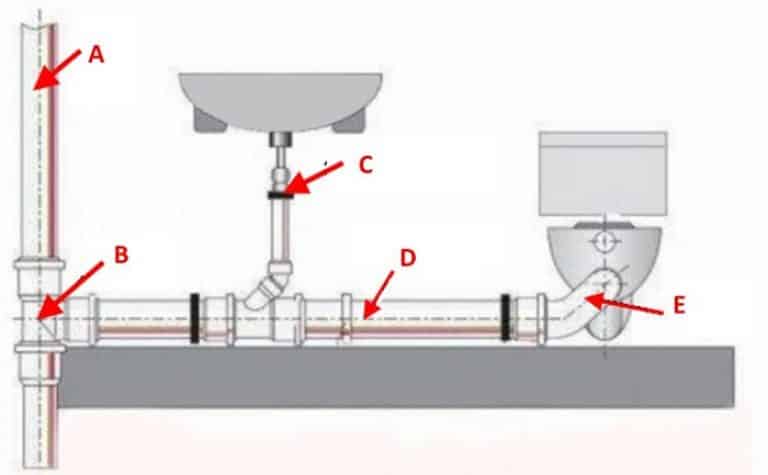
Rice. 8. Simplified layout of sewerage in the toilet
Designations:
- A - central riser;
- B - a branch made using a tee;
- C - siphon;
- D - sewer pipe;
- E - corrugated hose connecting the toilet to the pipe.
How to make a sewer without pumping?
To create a reliable non-pressure (gravity-flowing) sewer system during installation, you must adhere to the following rules:
- A slope should be created, it is selected as follows:
- for pipes Æ50 mm, this is 2.5-3.5 centimeters per meter;
- 110 mm - 1.2-2 cm;
- 150 mm - 0.7-1 cm.

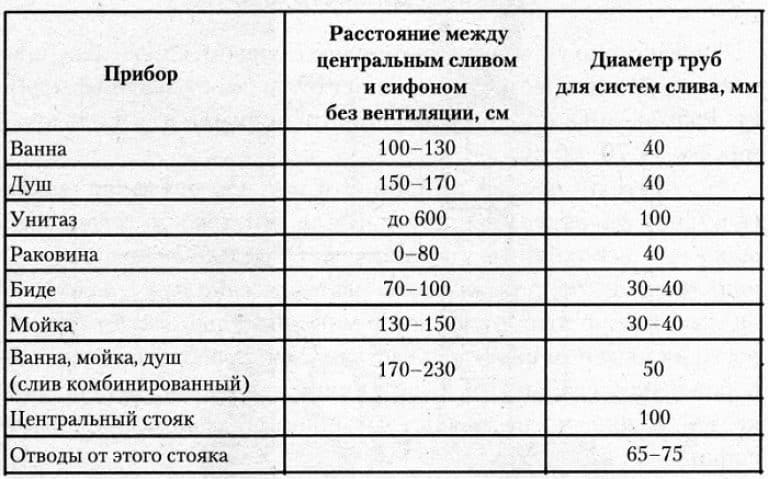
Do-it-yourself sewerage in the country from barrels
Let's give an example of the implementation of a home-made septic tank from three plastic barrels, where the first two play the role of overflow compartments, and the last one does not have a bottom, since it is used as a drainage well.
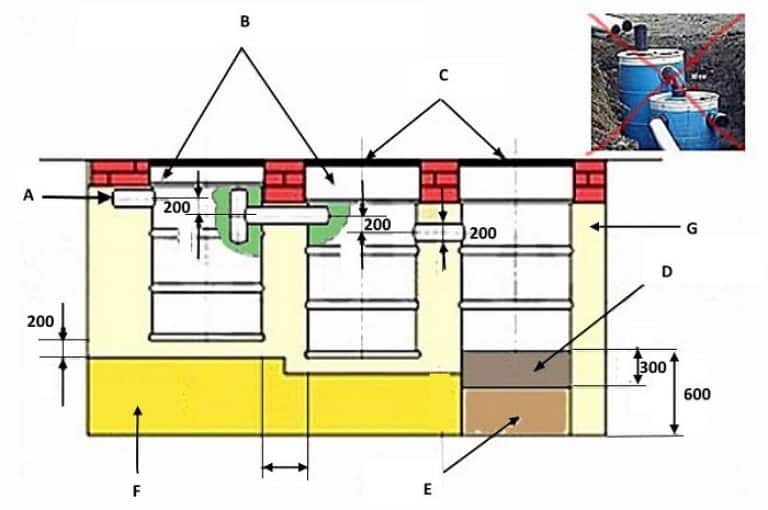
Designations:
- A - supply of wastewater;
- B - foam insulation (winter protection), if the site is in a warm climate, you can not install;
- C - hatches (must have ventilation holes);
- D - crushed stone layer;
- E - sand layer;
- F - soil;
- G - sand-cement compactor with a concentration of 5 to 1.
The advantages of such a scheme are the ease of implementation and the low cost of materials. If you work with a partner, the construction can be completed within a day.
Main disadvantages:
- small volume does not allow for effective cleaning;
- if the barrels are made of food-grade plastic, their service life under these conditions is about five years, after which there is a high probability of loss of tightness.
Instead of barrels, you can use eurocubes. The advantages of this design are the same as those of plastic barrel sewers. And the disadvantages should also be added to the high cost of the eurocube and problems with cleaning due to the small size of the hatch.
Sewerage in the country on concrete rings
Often, for the manufacture of a home-made treatment plant, reinforced concrete rings are used, a simplified diagram of such a design is given below.

The undoubted advantage of this solution is the long service life of the structure, as well as its high strength characteristics.
A significant drawback is the need to attract special equipment to mount the structure. It is almost impossible to build such an installation without it.
The main stages of arranging sewerage
The correct procedure will allow you to rationally manage the allotted budget and time for laying the system. The algorithm of work is the following:
- The first stage is design. It is necessary to create two autonomous sewage schemes (internal and external) with reference to a specific object. Since you are making a project for yourself, it is not necessary to adhere to the standards for the development of design documentation, a simple sketch with dimensions will be quite enough. This will not only give a complete picture of the scope of the upcoming work, but will also allow you to draw up an estimate for the necessary materials.
- The second stage is the procurement of materials. You should not choose cheap products from the land of the rising sun. Check the quality of the goods, because the reliability of the system depends on it. We also note that domestic manufacturers also produce good products.
- The third stage is the installation of internal wiring, the installation of plumbing equipment and its connection to the system. We recommend that you pre-mark the laying route, it is quite possible that in the process of this, factors not taken into account in the project may be found, for example, steel beams in the way of laying pipes.
- The fourth stage, it is necessary to carry out markings on the ground for the external part of the sewer (pipe trenches, a pit for a cleaning system and drainage fields).
- The fifth stage is earthworks. This is the hardest part. It is easier to attract special equipment for this purpose (if there is such an opportunity), which will significantly speed up the process. It is necessary to dig a trench under the pipe to the treatment tank, a foundation pit for it and equip drainage fields. It is better to dig in the "dry" season, for example, in August - September. Ideally, it is desirable to dig a pit and install a treatment structure in it within one day.
- The sixth stage is the installation of a treatment system, the laying of external pipes, the arrangement of drainage fields, the connection of all elements into a single system.
- The final stage is testing the internal and external parts of the system. If everything is in order, then the external elements are backfilled with soil, otherwise the flaws are preliminarily corrected.
Norms for placement
In sanitary standards there are certain restrictions regarding the installation of treatment facilities, here is a list of them:
- to the water well should be at least 50 m;
- indent from residential buildings - 4 m;
- between the roadway and the pit - 5 m;
- to the border of the site, at least 5 m;
- shrubs and trees should grow no closer than 3 m;
- from the reservoir it is necessary to retreat 30 m, rivers and streams - 10 m.
In addition, when choosing a place for a sewage treatment system, it must be borne in mind that there must be a free access to it for a sewage truck.


